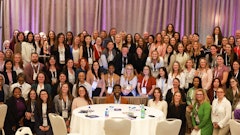
At the current pace of change, it will take until 2158 to reach full gender parity, according to the World Economic Forum. That’s why this year’s International Women’s Day theme is Accelerate Action, emphasizing the importance of taking swift and decisive steps to achieve gender equality.
There is a need for increased momentum and urgency in addressing the systemic barriers and biases that women face. Here are ways supply chain organizations can accelerate action in the professional sphere.
Changing attitudes and making progress
Attitudes toward supporting other women in the workplace have evolved significantly, and with mentorship programs and other initiatives, inclusivity is being supported from the top down.
One of the biggest evolutions is to invest in structured sponsorship programs that actively match senior leaders with high-potential women. This kind of sponsorship early on helps female leaders shift the conversation from “let’s hope women progress” to “let’s make sure they do.” It’s a straightforward, tangible action that any organization can replicate. Having mentors who challenge and support young leaders help them navigate these challenges and recognize their strengths.
This shift in attitude is often influenced by a dedication to changing a workplace’s culture. The minute people stop focusing on the gender and instead focus on what that individual can bring to the team; that’s when you know you’re working for an organization with a truly inclusive culture.
There’s a difference between genuine inclusion and tokenism, though, and it’s not hard to spot. Even the most successful environments don't just ensure women are represented; they actively value diverse perspectives, create meaningful platforms for all leaders to contribute, and integrate different viewpoints into decision-making processes.
Genuine inclusion always starts from the top down by having representation in senior roles. Seeing more women step into senior leadership roles is proof that progress is happening, and it’s not just about filling quotas—it’s about recognizing talent, hard work, and the right people for the job.
Shining a light
Having women in senior leadership roles is one thing, but it’s crucial that they use their position to highlight and support other women. Nothing accelerates action like women being showcased and supported. Female leaders should make it a point to nominate other women for high-visibility projects, external speaking opportunities and to represent their business at events and create a space in meetings for their voices to be heard.
Going a step further, women need to invest time in other women, creating pathways for visibility and advancement wherever possible. Women-led networks allow like-minded women to come together and affect change.
No more imposter syndroms
Particularly in typically male-dominated fields, how can we ensure women’s voices are being heard? Encourage proactive advocacy whereby women actively pursue opportunities instead of waiting for them to be offered.
Women need to push beyond the imposter syndrome and proactively pursue growth opportunities even when the experience or skillset isn’t a perfect match.
But, there’s still a long way to go in many industries, particularly in creative roles, where women are still underrepresented in creative director and other leadership positions. That needs to change. It’s important that companies don’t view this as a tick-box exercise; it’s about making sure talented women are actively promoted, mentored, and supported to step into these roles.
To foster a truly inclusive workplace culture where women can excel in leadership roles, companies need to ensure individuals feel comfortable expressing their ideas, asking questions, admitting mistakes, and taking risks without fear of embarrassment or retribution. Creating a psychologically safe environment is crucial, and businesses must champion ideas, create more inclusion, provide more opportunities, and create a seat at the table.
Inspiring momentum for change
Looking ahead, what more can be done to accelerate action in the workplace and move closer to true gender equality?
Continuing to raise awareness every day – not just on International Women’s Day – is vital. It’s about consistency, making small and positive change habitual within the workplace. It’s about fostering networks and a sense of community to help women connect outside of their day-to-day interactions, both cross-functionally and across levels of seniority. These connections break down silos and barriers to build coalitions that can advocate for change and establish safe spaces where women can discuss challenges and share success strategies.
Additionally, it’s time for men to step up and use their voices to advocate for women too. Whether it’s putting their name forward for big opportunities, backing them in key meetings, or ensuring they’re included in leadership conversations, these actions make a real difference. Training on unconscious bias, inclusive hiring, and workplace behavior should go beyond theory and lead to real, actionable changes in how decisions are made.
Without steadfast company policies and initiatives, there’s no structure for gender equality to be supported on.
Companies need to anchor diversity, equity and inclusion (DEI) initiatives and policies into business outcomes. Companies with diverse teams consistently outperform those without, so making the business case for inclusion is essential. The key is to integrate DEI into business strategy and not treat it as a standalone initiative that is seen as someone else’s problem.
We must fuse individual passion with organizational backing. It starts with speaking candidly about the inequalities -- calling them out without fear – and then championing practical fixes like inclusive hiring panels and continuous leadership development for underrepresented groups. Momentum thrives on results we can see and replicate.



















